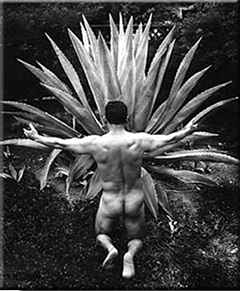 |
 |
 |
 Entertainment | December 2005 Entertainment | December 2005  
At Don Crispin's, Making Tequila is an Art Form
 Tom Uhlenbrock - Louis Post-Dispatch Tom Uhlenbrock - Louis Post-Dispatch


| Paying Reverence to Tequila

Mayahuel, the Aztec goddess, produced from her breast from the first alcoholic drink of the Americas.

Called pulque, this spirited beverage gave rise to mezcal and tequila, Mexico’s national drink.

Like their country of denomination, the history of these libations reflect the turbulent growth of Mexico herself.

Originating in the indigenous populations, transformed by foreign invasions, and finally building identities of their own after a revolution, the offspring of pulque are emerging as the world’s greatest new spirits.

Although mezcal and tequila have been the most under-appreciated and misunderstood spirits on the market, this past decade may well be tequila’s golden age, an era of enlightenment. (Janaap Dekker) |
Puerto Vallarta — Don't visit the Don Crispin tequila distillery looking for margarita makings.

The distillery sells 100 percent pure blue agave tequila. The good stuff. Mixing it with a sugary margarita mix would be a sacrilege, said Adrian, who was pouring samples of the product.

"You don't drink good Scotch with Coca-Cola," he said. "You drink good tequila for the bouquet, the taste. It makes you feel warm without burning your mouth."

We were in a town called Las Juntas y los Veranos in the tropical rainforest that drapes the Sierra Madres south of the resort town of Puerto Vallarta. This is the Mexican state of Jalisco, the home of tequila.

Originally, by law all tequila had to be made in Jalisco, much the way one region of France produces Champagne. Although that law was changed more than two decades ago, there are only two Mexican tequila distilleries outside Jalisco.

The blue agave, or maguey, plant grows best in the mineral-rich volcanic soil of the mountainous region. The Tiquilino Indians learned to cook the heart of the plant and ferment the juices. The Spanish introduced the distillation process that produces the aromatic liquid that we know today.

Which brings us to fallacy No. 1 about tequila. Agave is not a cactus. The blue, pointy plant, which decorates many desert gardens in the American Southwest, is a succulent that actually is related to the lily. Only blue agave is used to make fine tequila, and the plant can grow up to 8 feet tall with a lifespan of 15 years.

Fallacy No. 2: There is no worm in Mexican-bottled tequila. There is a worm, actually a butterfly caterpillar, in some types of mezcal, a related drink. And some American-bottled tequilas add a worm to impress the gringos.

In making tequila, Adrian explained, the heart of the plant, which looks like a 200-pound pineapple, is covered with lava rock and cooked for three days.

"We cook it the old-fashioned way, in that firepit right there — it's the Mexican microwave," he said. "Cooking concentrates the sugars. Then we chop it up and grind it to get the juices. The juice in those containers is bubbling because it is fermenting by itself. The process takes six to eight days; then it is ready to distill."

The fermented juices are distilled twice in copper kettles. The clear liquid that condenses out is raicilla, the Mexican moonshine that is a local drink. Tequila is made by aging the liquid in white oak barrels for three months, where it takes on the golden color.

The talking over, Adrian began pouring samples into small white cups and passing them around. He made his audience breathe in the aroma before emptying the contents with a popular Mexican toast — up, down, middle, inside.

The final sample was a delicious coffee-flavored tequila that is used as an after-dinner drink, priced at $18 a bottle.

Good tequila can be expensive. The bottles marked "100 percent pure blue agave" tequila at the duty-free shop at the airport cost up to $40 a fifth.

"Now comes the question of $64,000," Adrian said. "How many bottles are you allowed to take home free of taxes?"

The answer is four, with a $3 tariff on any over that amount.

For everything you ever wanted to know about tequila, and a lot more, author Ian Chadwick has a 14-part report at ianchadwick.com/tequila. | 
 | |
 |



